The Story, and the Science, behind BU’s COVID-19 Dashboard

Nasal swabs containing community samples, collected from sampling sites across BU, are brought for processing to BU’s Clinical Testing Lab, pictured here. A public-facing dashboard is updated daily to report the number of positive, negative, and invalid results. Photo by Janice Checchio
The Story, and the Science, behind BU’s COVID-19 Dashboard
BU scientists are “all hands on deck” supporting a one-of-a-kind system comprising custom software, real-time campus network modeling, contact tracing, and case cluster management
On August 17, Boston University began posting the results of its university-wide coronavirus testing program on a public-facing dashboard. Visitors to the site can now instantly see how many tests BU has performed in the past day or the past week, the total number of positive, negative, or invalid cases recorded, the overall percentage of positive cases at BU in comparison to the city of Boston and the commonwealth of Massachusetts, and more.
“Because of the huge amount of anxiety surrounding this disease, what’s so important is that we be as transparent as possible about exactly what we’re doing, what the health of our community is, and how it’s changing over time,” says Robert A. Brown, BU’s president. The public-facing dashboard, he says, is meant to give people confidence in BU’s coronavirus surveillance and containment efforts—a process that not terribly long ago would have seemed unimaginable for a university to undertake entirely on its own.
Brown says the dashboard will help answer the important question: in terms of infection rate, “is BU better off or worse off than the community at large? That’s the transparency we need to know, and the community around us needs to know.”
But the public-facing dashboard represents only one of many aspects in BU’s broad coronavirus efforts. The university-wide testing program hinges upon the new BU Clinical Testing Lab, which was rapidly outfitted with machinery and custom software over the summer. Now up and running, it’s capable of processing up to 6,000 coronavirus tests per day.
“One thing we did early on was to commit to building out a testing facility at BU,” Brown says. “As we first began understanding this disease in March and April, it became clear to us that there would be no way to control spread within a university without surveillance testing.” That’s because scientific studies indicate that up to 40 percent of people infected with coronavirus could be asymptomatic, putting them at risk of unknowingly spreading the virus to others. “Routine testing is the only way to find everyone who’s infected.”
Brown appointed Gloria Waters, BU vice president and associate provost for research, to coordinate teams of BU scientists to make an on-campus coronavirus testing and surveillance program a reality—and to do it quickly, so it would be ready for the arrival of students come August.
“The testing itself is only a part of our program,” Brown says. “Without the testing, you’re blind—with the testing you have data about the people in your community who have the virus. Then the question is, what do you do with that data? The whole area of contact tracing, quarantining, placing infected people in isolation, being able to counsel people so that they comply with guidelines, having the right software that moves this data to the people making decisions based on that data—this was an all-hands-on-deck moment for BU’s scientific community.”
Simulating BU’s community using network science
BU’s testing protocols—sampling undergraduates twice per week and student-facing faculty, staff, and graduate students once per week—have been vetted by a complex network simulation of BU’s campus and community, built upon a rich trove of data, designed to predict how coronavirus might spread among students, faculty, and staff. That network simulation was adapted from an epidemiological model supported by the Bill & Melinda Gates Foundation and customized by BU scientists to represent the movements and patterns of the BU community.
“The type of modeling we’re doing is a network-based model, meaning we’re modeling individual behaviors,” says Eric Kolaczyk, director of BU’s Rafik B. Hariri Institute for Computing and Computational Science & Engineering, who leads the simulation team. “Our primary data sources include class registration and schedules and housing information about all on-campus students. Mathematically, we’re calculating with a reasonable level of reality how individuals interact with each other and how coronavirus propagates through such contact within BU’s network.”
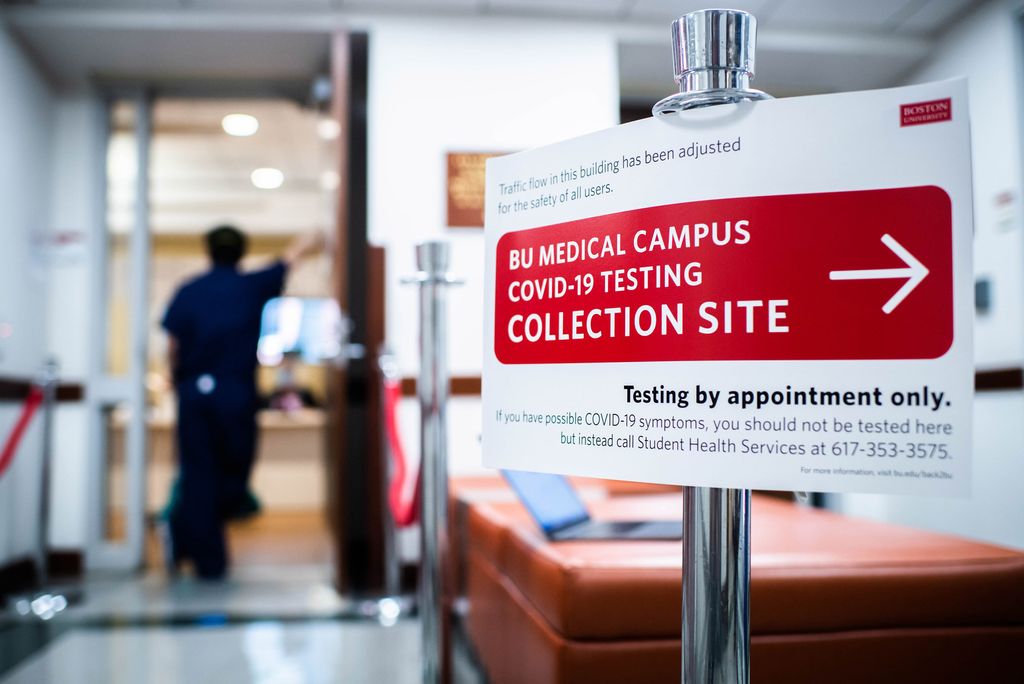
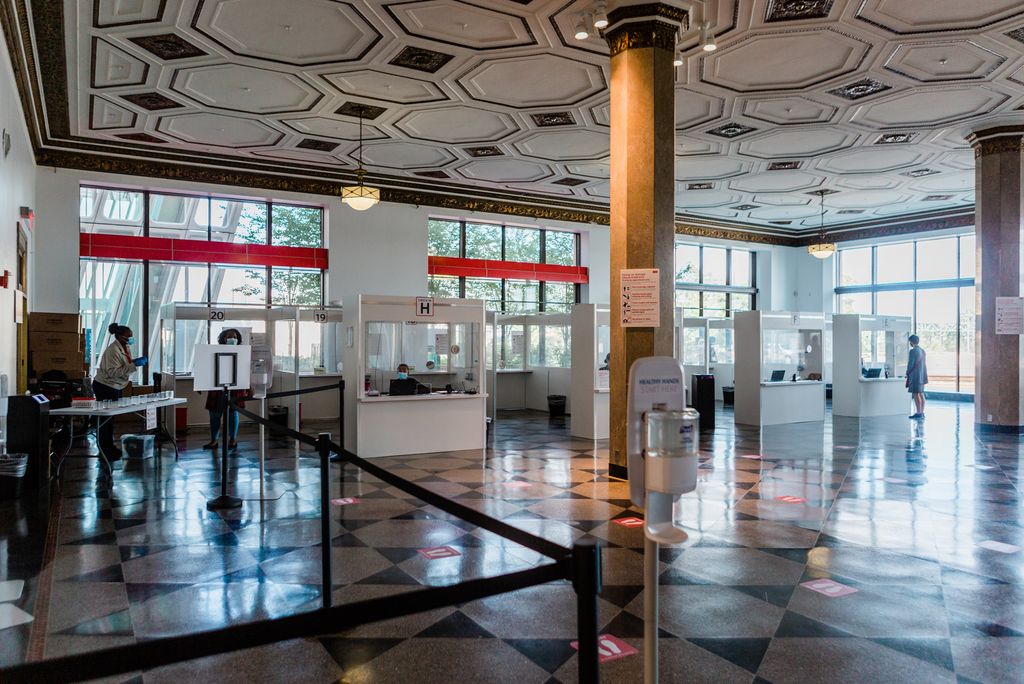
Twice per week, BU undergraduates must visit one of BU’s sampling sites to perform a nasal swab for coronavirus testing. Student-facing faculty, staff, and graduate students must do so once per week. Photos by Jackie Ricciardi (left) and Janice Checchio
Although the campus simulation is specific to BU’s community, the scientists who developed it made use of existing research as well as the latest evidence-based information about how coronavirus spreads.
“We’ve really benefited from a lot of research going on in understanding COVID dynamics,” says biostatistician and epidemiologist Laura White, a BU School of Public Health associate professor of biostatistics. “We used existing statistical calculators to see how building airflows might impact COVID transmission and how given classroom densities would influence transmission probabilities.”
Models to understand the spread of infectious diseases have long been honed by public health experts, epidemiologists, and statisticians. But coronavirus-specific parameters are still being developed as scientists learn more about the virus.
“It’s very much a moving landscape, but there are some important points of convergence related to how long it takes people to develop symptoms, how much asymptomatic transmission and disease might be occurring—we’re seeing multiple studies corroborating similar numbers,” White says.
Adopting the coronavirus model funded by the Gates Foundation, Kolaczyk says the team built a BU-specific system so that individual departments around the University could input data for processing. On top of the data that portray how individuals move through campus—from their dorms to classrooms to COVID-19 testing sites—and who they encounter along the way, are dozens of mathematical calculations representing infection probabilities.
“If you have two people interact, if one of those people has coronavirus, what is the likelihood the other person might be infected?” says Kolaczyk, a professor of mathematics & statistics and systems engineering at BU’s College of Arts & Sciences and College of Engineering. Using calculations, he and the team determined baselines for how likely transmission would be between any two people. Using person-specific data, the simulation can even predict how likely mild, moderate, or severe disease is based on age.
To test out the effectiveness of BU’s coronavirus surveillance program in preventing the spread of the virus, the researchers used the model to simulate the campus population and its traffic patterns during the academic year of 2019–2020, and what would happen if any sick individuals moved through that network.
“These are super computationally intensive models,” Kolaczyk says. “Every time a sick person comes in contact with someone else, it’s not guaranteed that coronavirus will spread. When you’re running a campus simulation on the level of individual people, and how they move around and come into proximity with each other, you’re computationally flipping hundreds of millions of coins—the probability of transmission—over and over.”
To thoroughly explore the range of likely infectious rates over time that could occur on campus, the BU scientists are running those simulations tens of thousands of times, capturing not only the average expected infection rate, but also the upper and lower bounds of what’s possible.
“One thing with modeling is that it’s always important to have confidence in the computations that you do,” says computational expert Katia Bulekova, the manager of scientific programming and applications at BU Information Services & Technology (IS&T)’s Research Computing Services group. “The more times you flip a coin, the more data you have. We ran thousands of simulations to make sure our results were reproducible.”
Bulekova says Kolaczyk, who spearheaded the modeling team’s efforts, was extremely clear with everyone in the group that the simulation was to be used to generate unbiased data, rather than be used to prove any preconceived notions.
“He said to us, at no point will we use this model to try and prove that any proposed precautions would make a difference,” Bulekova says. “He made it clear that we would simply research how precautions might impact the spread of the virus, and be transparent about our findings based on the model.”
She says the input data won’t be shared because of privacy concerns, but all the computations are publicly available. “If someone at BU or anywhere else wants to look at whether our computations make sense, they can look at our code,” she says.
The type of computing power required to drive BU’s model is huge. Bulekova and the team make use of a vast computer network that resides 90 miles west of Boston, in Holyoke, Mass. Known as the Massachusetts Green High Performance Computing Center (MGHPCC), its computational network is made up of hundreds of thousands of processors—spread across 10,000 computers—that work together to solve data-rich mathematical problems that wouldn’t be possible on individual devices. The MGHPCC is a collaborative research tool supported and used by BU, Harvard University, Massachusetts Institute of Technology, Northeastern University, and the University of Massachusetts, as well as the state government and members of private industry. It’s also funded by the National Science Foundation and the Massachusetts Life Sciences Center.
Powered by a computing cluster at the MGHPCC, the BU model showed that by incorporating mask-wearing, campus de-densification, and other precautionary measures, as well as campus-wide testing, contact tracing, and isolation of infected individuals, it was possible to flatten an infection growth curve.
“We can’t say anything with certainty—we are speaking a language of probability here,” Kolaczyk says.
But the model gave BU leadership the confidence to move forward with its plan of bringing back residential campus life, albeit with many new precautions and parameters in place. Now, it’s up to the BU community to adhere to safety guidelines. “We can model all we want, but if the safety measures aren’t implemented [by the community] then we are looking at those higher curves,” Kolaczyk says.
Predictive modeling to control infection rates
In planning for the return of residential undergraduates, BU also made use of epidemiological tools that calculate, given a student’s state or country of origin, how likely they are to arrive at BU already infected with coronavirus.
“You can calculate these probabilities using individualized data about the student body, to say, if someone is coming from a specific place, how likely are they to bring coronavirus to you?” Brown says. “We have those estimates, and we’re ready. It’s one reason why we spread out the return of our students over several weeks, so that we can deal with infected students, systematically, as they arrive on campus.”
So far, Brown says, the actual infection rate has been far lower than what the calculators estimated.
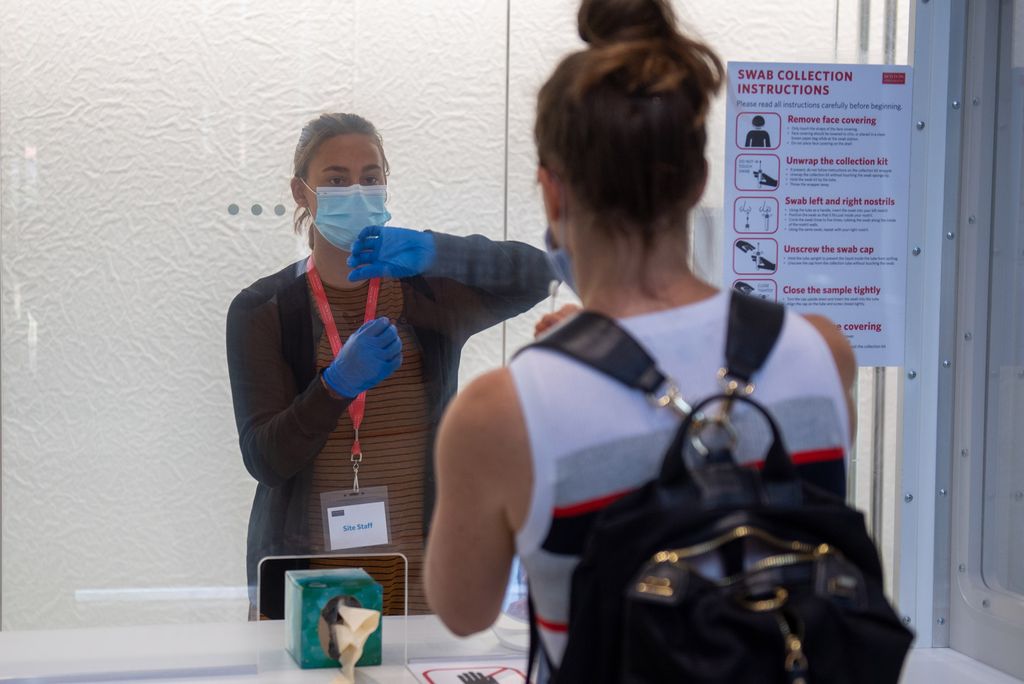
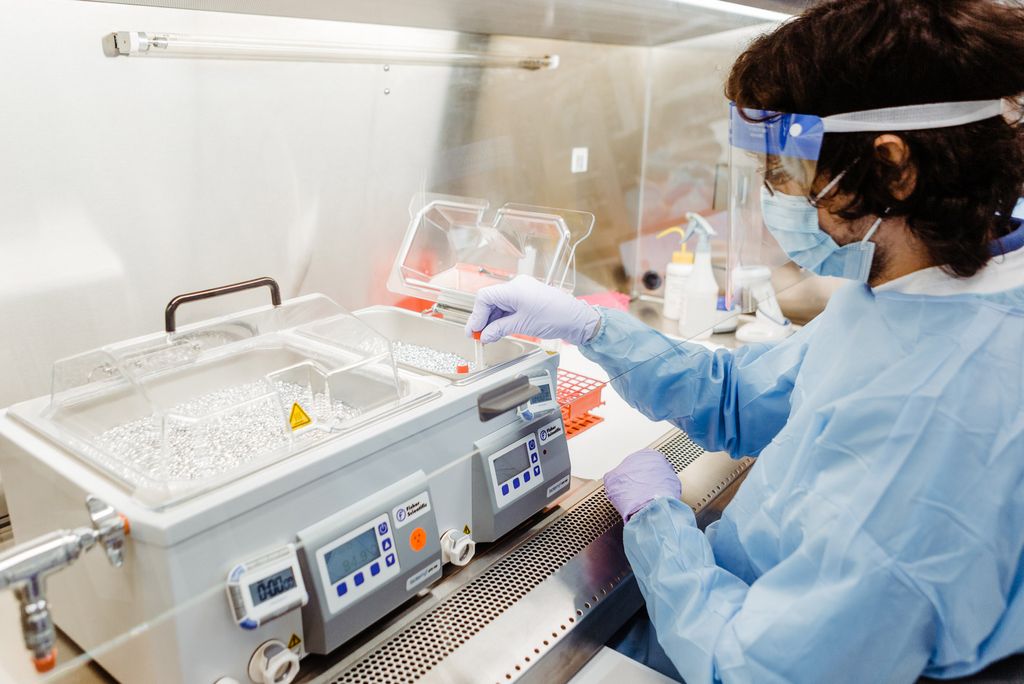
After members of BU’s community self-swab their nostrils at one of BU’s sampling sites, medical couriers bring samples to BU’s Clinical Testing Lab, where they are processed and tested for the presence of coronavirus. Photos by Cydney Scott (left) and Janice Checchio
As students, faculty, and staff return to campus, Kolaczyk and the modeling team are switching over the simulation so that instead of modeling historical data, it models what’s happening at BU—and who exactly is on campus—in real time. For that to be possible, Bulekova and others from BU IS&T designed custom front-end and back-end software to make it easy for departments across BU to easily input the most up-to-date data into the simulation.
“We’ve been marrying up the data on record about students through online portals collecting information about where students are, how they each plan to use the Learn from Anywhere (LfA) options, what their class schedules are, what home state they are coming from—there’s a whole variety of information being fed into the software,” says Linette Decarie, assistant vice president of analytical services and institutional research at BU IS&T. “Some of this information we glean directly from the students; they have access to an online portal where they can indicate their plans to go to class or to learn online, and they can update that information at any time.”
Using all these data points combined with test results from the BU Clinical Testing Lab, the campus simulation will function like a heat map, says Carrie Landa, director of behavioral medicine and associate director of clinical services at BU Student Health Services, providing BU’s healthcare and contact tracing teams with a detailed view of any coronavirus activity in specific buildings, dorms, and classrooms.
“This data will help us decide exactly which resources we need to implement to respond to cases and prevent further spread,” she says. Since April, Landa has been serving on BU’s Medical Advisory Group, which was pulled together by Brown in response to the pandemic.
“We will scrutinize the data daily for weak points that could cause concern, such as how many of our isolation units are being used, how supply chains for testing materials are functioning, University staffing levels, and more. There are more than 20 metrics we’ll be looking at,” Brown says. He and other university presidents from across the state are part of a higher education task force, organized by Massachusetts Governor Charlie Baker, that has provided recommendations on strategies to safely reopen universities. Decarie also provided support to that higher education task force.
Keeping a close eye on community adherence
One uncertainty, according to Davidson Hamer—a member of BU’s Medical Advisory Group and a BU School of Public Health and School of Medicine infectious disease and global health expert—is whether everyone in BU’s community will adhere to the testing protocols and community safety guidelines. Hamer, who is also a faculty member at the National Emerging Infectious Diseases Laboratories at BU, has provided guidance to the Massachusetts higher education reopening task force that Brown is a part of.
“I think it will be interesting to see, among students, faculty, and staff, what’s the level of mask use, of filling out the daily health attestations, and how does that relate to the risk of disease outbreak,” Hamer says. “There’s a lot of practical public health [learnings] that could come from this.”
As students return to BU, and to other colleges and universities across Massachusetts, from out of state, Hamer says there will likely be an increase in cases coming into the state. Identifying those cases as early as possible will allow for isolation and exposure control, ultimately limiting the spread to others.
“Universities like BU are taking measures designed to identify sick individuals and separate them from everyone else,” Hamer says. “There’s going to be a small bump in cases, but hopefully it will then go right back down. The challenge is going to be enforcing the behavior of students; my hope is that student leaders will help peer pressure others to say, ‘You need to be wearing your mask, you need to get tested.’”
Hamer also says it’s going to be important for students to have the right kinds of masks, ones that are effective, and to have multiple masks on hand. “Ideally you want a mask that’s made up of two different materials, with two or three layers, that’s snug-fitting and covers the nose and mouth well without any air leakage—those masks are very effective,” Hamer says. “Those types of materials are washable, so if they get wet or dirty—which would make them less effective—you can wash them. You will want to have another mask on hand for when that happens. We know that things like bandanas, and fleece gaiters, they don’t work well at all, and might even make things worse. So, the type of masks people are wearing is really important.”
As a public health expert who not only provided guidance on universities reopening, but also advised the commonwealth of Massachusetts on recommendations for reopening businesses (and what warning signs would warrant ramping back down the state’s phased reopening plan), Hamer acknowledges that “it’s a delicate balance between keeping the economy going, keeping people happy, and keeping people safe and healthy.”
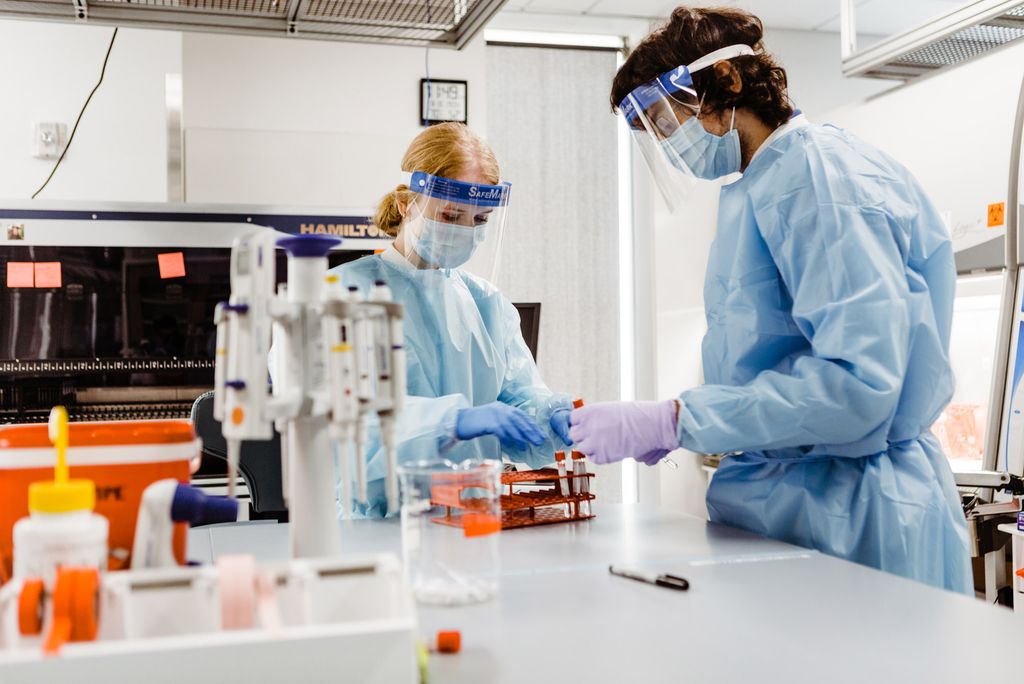

The BU campus simulation is detailed enough to function like a heat map, providing BU’s healthcare and contact tracing teams with a detailed view of any coronavirus activity in specific buildings, dorms, and classrooms. BU’s Clinical Testing Lab (pictured) has ample bandwidth to ramp up testing frequency within any areas of campus that show developing signs of the virus spreading. Photos by Janice Checchio
During the peak surge of cases in Massachusetts that spanned from April into May, Hamer, a member of the Boston Medical Center (BMC) adult infectious disease team, was on the front lines assisting with the treatment of critically ill patients at BMC, Boston’s safety-net hospital and BU’s teaching hospital. “I helped a fair amount with the treatment side of things, working with six other doctors at a time to chime in and say, ‘We think this person needs this drug,’ or make other assessments based off of a patient’s data. I saw, firsthand, how destructive this disease is,” Hamer says.
At BU, if the virus were to show signs of uncontrolled spread, Hamer says, the University could be forced to shut down dining and housing units or take other more drastic measures. But he remains cautiously optimistic. In order to control spread, he says, you need to test frequently. And he believes BU’s surveillance frequency is reasonable and has built-in controls to extinguish infections as they crop up.
“If all aspects of the system function as intended,” he says, “the risk to students, staff, and surrounding communities should be very minimal. I think we can keep things under control.”
Community-wide surveillance is changing the pandemic landscape
At BU, Brown and other scientists are watching to see what new insights into the coronavirus pandemic the University’s surveillance program can also reveal.
“This is a large-scale surveillance testing campaign—it’s not like testing that you hear about happening in any other state, and it’s different from what other institutions are doing,” Brown says. “The state of Massachusetts, or the city of Boston, for example, are administering medically ordered tests, where a physician has prescribed the test because someone has a symptom. That’s not what we’re doing. We’re testing everyone. The probability that people will have coronavirus is higher, in a medically ordered testing pool, than when you do massive surveillance testing like we are. As this continues to roll out at BU this fall, with our testing results shared publicly in all transparency, it’s going to be interesting to see how many asymptomatic infected people we find.”
The program could ultimately uncover new information about coronavirus that has implications far beyond BU’s campus. It presents a rare opportunity to see what the true asymptomatic rate might be for the novel coronavirus, and to evaluate the virus’ true rate of transmission between people.
“Within our environment, we’ll be able to understand much more about contact tracing than anyone knows yet, we’re going to have really good data on when someone tests positive, and we’ll find out how many contacts with other people they’ve had, and then we’ll be able to track how many of those contacts eventually develop the virus,” Brown says. “What is that true probability? Until now, there hasn’t been good enough data to figure that out.”
Brown says BU is in talks with other universities to create a data-sharing consortium, to pool together campus testing data for broader scientific purposes. And Kolaczyk’s campus modeling team has made their software code publicly available, open source via GitHub.
“Many other universities are two or more months behind BU in terms of modeling to support campus reopening and have been delighted to have access to our model,” Kolaczyk says.
“I’ve been extremely impressed with the coordination of this process; this is not a modeling exercise that happened in a vacuum,” he says. “I look at this as a tremendously humbling experience…. The weight of the implications is substantially greater than what you might normally do when you, as a scientist, are just working on a calculation simply because it’s interesting.”
Brown says there are many “unsung heroes” across BU whose herculean efforts have made it possible for the University to be at a point where students are back on campus. “There are people in procurement, who got us the robots and machines needed to run our new Clinical Testing Lab, which was not an easy thing to do—remember, back in the spring, there were many supply shortages stemming from the pandemic. The procurement team was very creative and worked very hard, securing us great pricing, to get the equipment and bring the cost of testing down, making this surveillance program a reality for BU.”
Now, “the best thing that can happen,” Brown says, “is that with all the protocols, mask-wearing, building ventilation measures, cleaning requirements, and so on, we acknowledge that although this is not the world we want to live in, it’s a world that we can safely live in—our community of 30,000 people working and living together, going to class, with an infection rate that’s very much under control—until there is a cure for the coronavirus.”

Comments & Discussion
Boston University moderates comments to facilitate an informed, substantive, civil conversation. Abusive, profane, self-promotional, misleading, incoherent or off-topic comments will be rejected. Moderators are staffed during regular business hours (EST) and can only accept comments written in English. Statistics or facts must include a citation or a link to the citation.